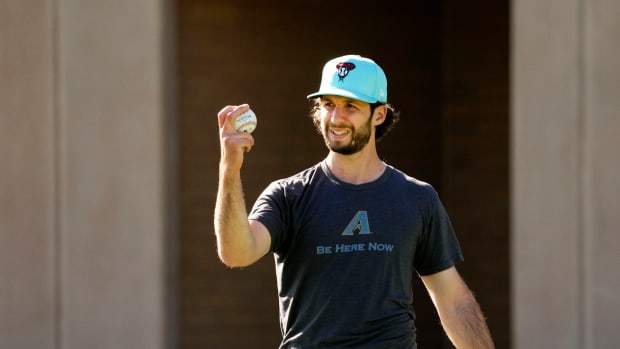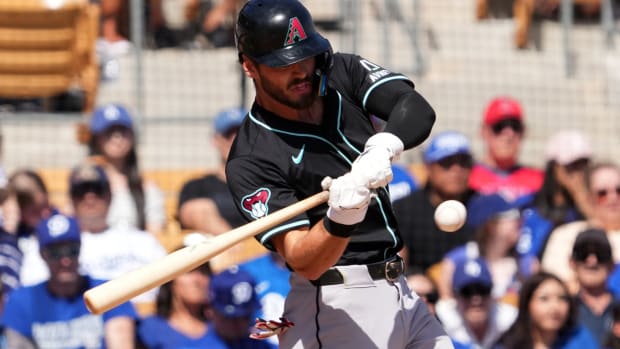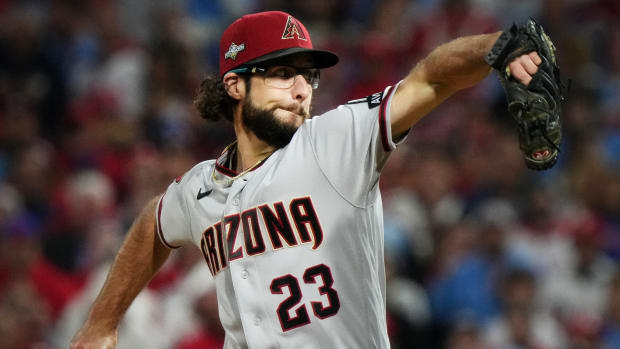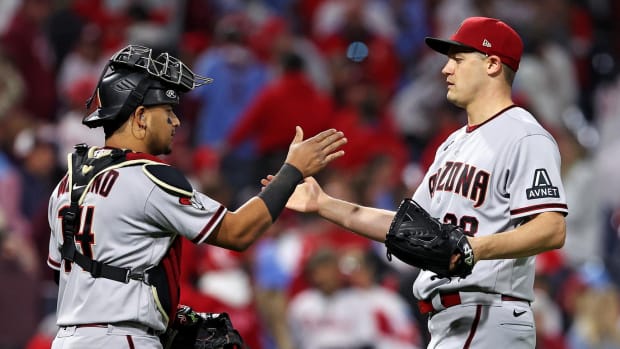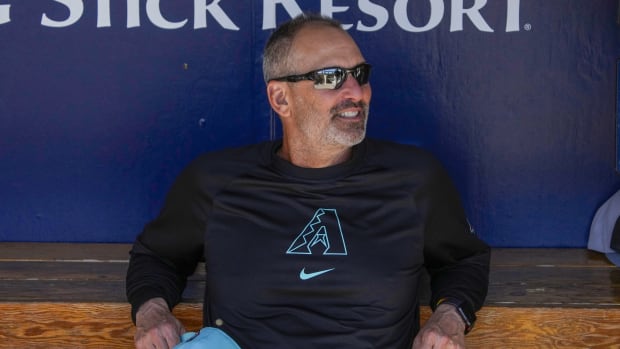How Daulton Varsho Became a Gold Glove Contender
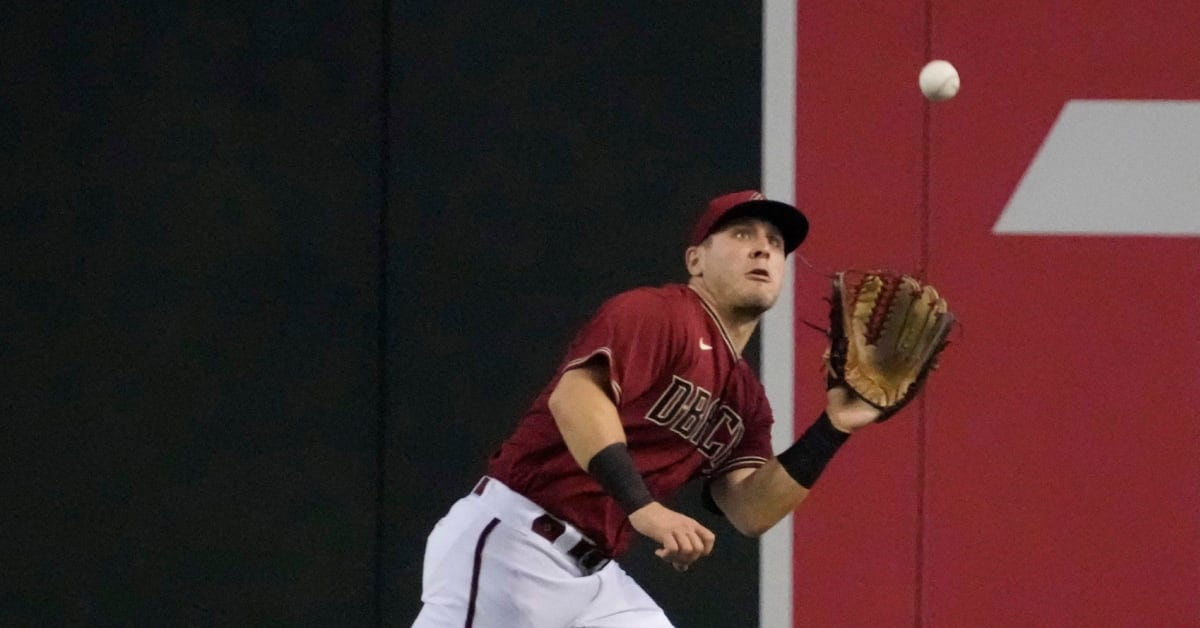
Note: This article has been updated to correct the spelling of Daulton Varsho's trainer Scott Scheuer's last name
With a runner on first base in the second inning and two outs, Zac Gallen was protecting a scoreless innings streak on Sunday that had run to 36 innings to that point. In stepped Tyrone Taylor who jumped on a cutter that stayed up and in the middle of the plate, driving it to the right center field gap. At the time Gallen thought, "There it goes, it must have bounced over the fence, it's a ground rule double". But right fielder Daulton Varsho raced to the warning track in front of the pool, and as he's done so many times this year, was able to track it down, making what Gallen described as "an unbelievable catch"
Gallen went on to voice the opinion that if Varsho is not the best defensive right fielder in baseball, "he's definitely up there." Gallen has a case, having a front row seat and being the beneficiary of Varsho's outstanding defensive play over and over. The nightly highlight reels are rife with images of Varsho racing across the field making diving catches coming in or going back to rob extra bases against the wall or in the corners.
Certainly other National League managers and coaches have seen enough of him this year to know that he has emerged as an elite defender as well. Whether seeing him live from the dugout, or reviewing highlight videos there is plenty of visual evidence available for them to consider. They'll have a chance to vote for him in the annual Rawlings Gold Glove Awards. Varsho has already qualified for consideration, having played 726 defensive innings thus far. (449 in RF, 277 in CF, 175 at C)
In addition to the eyeball test however there is also the trove of ever improving fielding data available for fans, coaches and executives to consider. Varsho is dominating the leaders boards in most of them.
Outfielder Jump is one metric that helps define and measure how quick a jump and how good a read the player is getting. This is a difficult area for fans watching at home on T.V. to evaluate. By the time the camera cuts away from the batter to the outfielder, it's usually too late to see the fielder's starting point or first few steps. Even when at the stadium it takes a trained eye to to evaluate properly. Fortunately this is a tool that fans can access publicly.
This metric measures only plays that had a 90% catch probability or lower so as to rule out the proverbial "can of corn". It is comprised of three components:
Reaction: feet covered in the first 1.5 seconds
Burst: feet covered between 1.6-3.0 seconds
Route: feet covered against direct line route to the ball
The resulting information is then used to create Feet vs. Average. Varsho ranks 1st in the NL. Here are the top 5 outfielders in the NL
| Player | Team | Feet vs. Avg. |
|---|---|---|
Daulton Varsho | AZ | 3.8 |
Jose Azocar | SD | 2.8 |
Mookie Betts | LA | 1.5 |
Lorenzo Cain | MIL | 1.4 |
Harrison Bader | Stl | 1.0 |
Another important metric is also from Statcast called Outs Above Average, or OAA. From OAA, a Runs Prevented number is calculated. Varsho's +13 OAA and +11 Runs Prevented leads all MLB outfielders. That is for all innings, at all outfield positions played. When isolated to just Right Field innings, his OAA and Runs Prevented are still first in the NL, well ahead of Mookie Betts, despite fewer innings played.
It should be noted for fans of using Fangraphs WAR metric that in 2022 they switched over to using Statcast Runs Prevented instead of UZR.
One more frequently referenced measure is Defensive Runs Saved, created by Sports Info Solutions and used in Baseball Reference's WAR metric. Here Varsho also rates +11 Defensive Runs Saved in the outfield, 3rd best in the NL. That is broken out by +8 in CF and +3 in RF.
Whether relying on more traditional methods for evaluating defense, which are most useful in the hands of a trained scout, coach, or former player, or using the modern defensive measures now available to the public, it's clear that Varsho has become an elite outfielder and is deserving of strong consideration for the NL Right Field Gold Glove. Since Varsho is playing his first full season in the outfield and split time between RF and CF, It may be difficult to outright win the award over an established star such as Betts. But at the very least, if Varsho is not a finalist that would be a grave oversight.
For his part, Varsho didn't just fall out of bed and become a great outfielder on athleticism alone. While it's true that Varsho is blessed with excellent speed and a "nose for the ball", it's taken a lot of hard work to get to this point. D-backs manager Torey Lovullo said that Varsho worked closely with Dave McKay to hone his skills this past spring training, focusing on footwork. But it started even before then. Varsho explained how he spent the off season working with his trainer from back home, Scott Scheuer, the same trainer he's had since 6th grade.
"I told him the big thing this year is I need to be able to get my hips to turn open, so that was a big thing even coming into spring, making sure my hips were going to be able to work open"
He also referred back to teachings from his father, former major leaguer Gary Varsho
"He always does like a clock. So you make sure that your foot has to get to 5 or 6 O'clock depending on where the ball is at. That's a big one for me. I want to make sure that I'm trying to open up and I'm not getting stuck at the 4 O'clock position..........every day when I do my basic routine making sure when I do go for a ball I'm opening up first instead of just being lazy and opening up a little bit"
It's work and dedication like this that leads to ranking first on an outfielder jump board. But it doesn't stop there. Soaking in tips from coach Dave McKay provided valuable lessons. While going through the transition from CF to RF Varsho said
"I was having some difficulty opening to my right side, and he said I should start with my left foot a little bit more forward and making sure you can open up to that gap. He has little things like that he's picked up on. "
Perhaps the most interesting anecdote was this tip he picked up from veteran outfielder David Peralta
"When David was here he taught me so much about little stuff, like opening your mouth when you're going after a fly ball when it's high because when you have your mouth closed your eyes are going to start bouncing."
Varsho is already taking the lessons he's learning and sharing with his teammates, and after team meetings McKay will gather the outfielders around and they will discuss what they could have done better on specific plays. He talked about a play against Philadelphia where he threw to 3rd base on a hit, allowing the batter to advance an extra 90 feet to second base. After reviewing amongst the outfielders after the game, the next day there was a play where Jake McCarthy fielded a ball up the middle with a runner going to 3rd and he threw to the correct base(2b) preventing the batter from moving up 90 feet. "It's pretty cool to see when we learn from each other's mistakes" It's ethic and teammates supporting each other in this manner that are the intangibles that are often sought but seldom understood.
The day to day work does not stop there. Even shagging balls in the outfield is an opportunity to learn the nuances of playing a particular field, especially on the road.
"I think you have to understand the place you're at. For me , especially San Francisco is really tough with that brick all the way up. You've got to take your time and understand every wall that you're going to be in for every stadium. So Batting Practice is sort of a big thing for me. It's more defensive work than offensive work. I've got to understand how to be able to save some pitchers some breaks out there. "
Daulton Varsho is a gifted athlete that works extremely hard to perfect and hone his craft and share whatever he is learning with teammates. We seldom get to see what goes into making plays such as those in the highlight reel below possible. But knowing more can help us further appreciate them.


